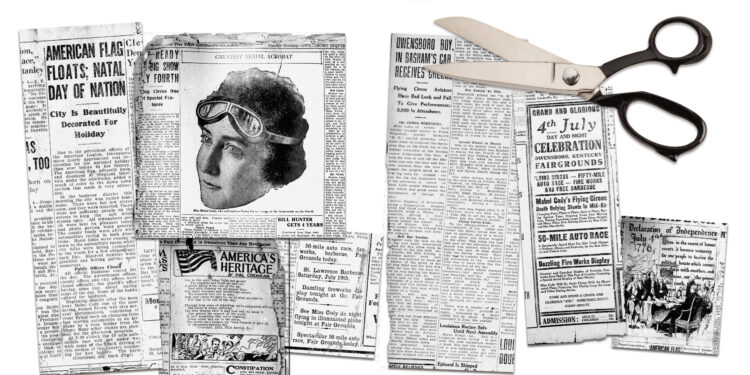Celebrating Independence Day in 1924
The Fourth of July – more commonly referred to then as Independence Day – was celebrated in spectacular fashion in Owensboro back in 1924, when residents of our fair city were a century closer to the event so commemorated than we are today.
The Owensboro Fairgrounds invited the entire community to “come and spend a grand and glorious” day, with “something doing every minute.”
Admission? 50 cents for adults, 25 cents for children. A small price to pay for a fantastic array of events and activities, highlighted by a flying circus, an automobile race, fireworks and free barbecue.
That flying circus featured the “greatest aerial acrobat” Miss Mabel Cody and her troupe of daredevils, performing “death-defying stunts in mid-air.” Those feats were to include “changing from a fast-moving automobile to an airplane by a rope ladder from the plane” as well as “changing from plane to plane … stepping from fast moving cars, daring parachute leaps from dizzying heights and many other hair-raising stunts.”
The intrepid Miss Cody was also scheduled to perform “night flying with an illuminated plane featuring her daring loop the loop and other daring stunts.” This “special aerial display of rare beauty” was to take place in conjunction with a “dazzling fireworks display” that promised to be the “greatest and grandest display of patriotic fireworks ever held in this part of the country.”
Alas! The following day’s newspapers reported that the flying circus was unable to perform, “due to a wreck of one plane and motor trouble in the other.” The wreck took place “while landing in the field near Griffith Avenue (and) crashed into a fence, which was not visible to the aviator.”
As for the fireworks themselves, the display included a 25-foot-tall replica of the Statue of Liberty “to be reproduced in lines of fire,” along with the Liberty Bell and a sparkling Niagara Falls.
For those who enjoy their thrills a little closer to the ground, the fairgrounds was also to host a 50-mile auto race – a 100-lap “spectacular speed meet” that would award bragging rights and “dirt track honors of Indiana, Illinois and Kentucky by the best drivers and fastest cars.” The $500 purse for this race was to be divided among the top four winners, with first place taking $250, then $125, $75 and $50. By the way: A quick Google search indicates that the fastest cars of 1924 reached speeds between 88 and 130, depending upon track conditions and the type of automobile being raced.
Taking the checkered flag in that race was Frank Brumfield of Owensboro, driving “Basham’s B.B. special,” finishing the race without ever having being forced to the pits. The report published in the Owensboro Messenger the following morning boasted that “the time it took for him to reel off the fifty miles was only one hour and fourteen minutes.”
But one needn’t have traveled to the fairgrounds to enjoy the patriotic fever of the holiday. The American Legion had worked diligently to display the U.S. flag “properly hung and displayed at frequent intervals along the sidewalks,” adding “a touch of color to the downtown section that made it very attractive.”
Most stores in the business district were closed for the day, but roads were “alive with automobiles racing in both directions. Rural folks were coming to town to the automobile races, while city folks were hying themselves to the woods for a few chigoes (fleas) and such like. Squirrel hunters were plentiful and fishing parties were numerous.”
That spirit was celebrated in the opening stanza of a poem titled “America’s Heritage”:
“Out in the open, today folks are gropin’
For sunshine and fresh air and rest.
A picnic affray is the call of the day
And with freedom we all appear blest.”
The poem concludes with the following lines, which we believe are as true today as they were 100 years ago, and we hope will continue to be true in all the centuries to come:
“It isn’t surprising that we’re realizing
From cities ’way out to the sticks,
The world can’t enslave us; ’twas freedom it gave us,
In Seventeen-Seventy-Six.” OL










